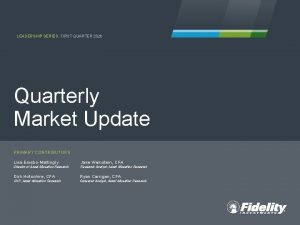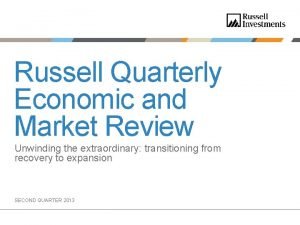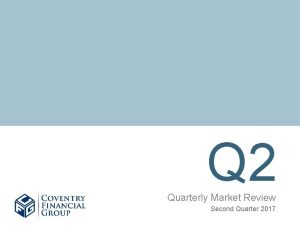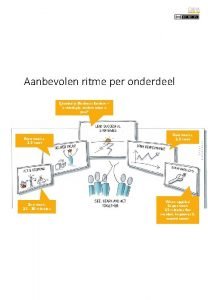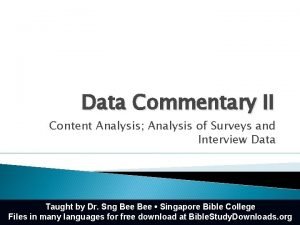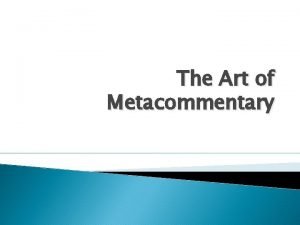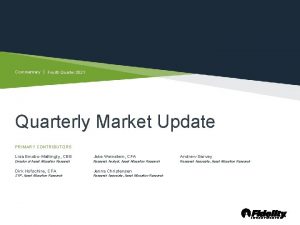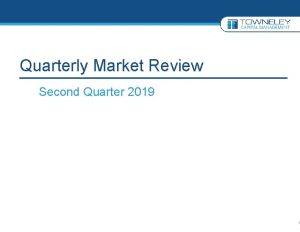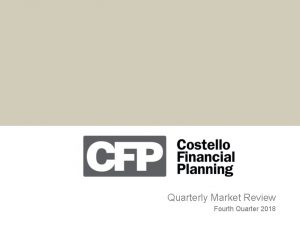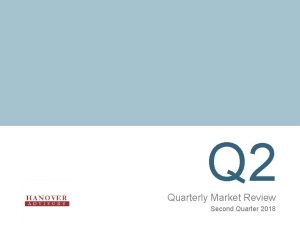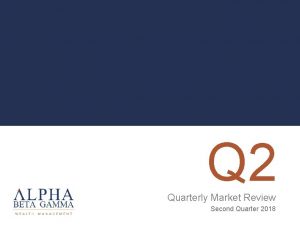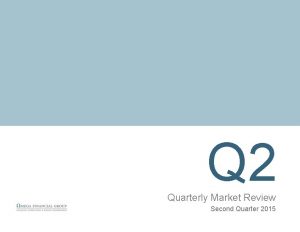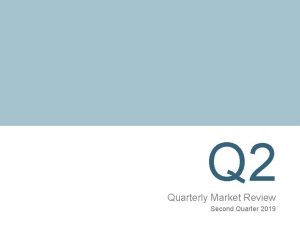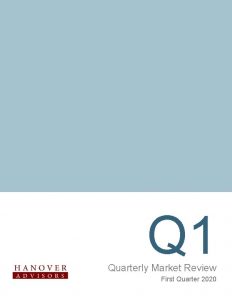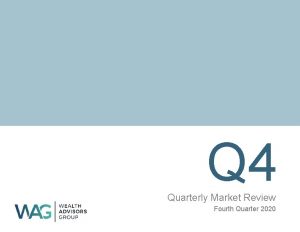Commentary Second Quarter 2020 Quarterly Market Update PRIMARY
















































- Slides: 48

Commentary Second Quarter 2020 Quarterly Market Update PRIMARY CONTRIBUTORS Lisa Emsbo-Mattingly, CBE Jake Weinstein, CFA Director of Asset Allocation Research Analyst, Asset Allocation Research Dirk Hofschire, CFA Jenna Christensen SVP, Asset Allocation Research Associate, Asset Allocation Research

Table of Contents Market Summary Economy/Macro Backdrop Asset Markets Long Term Themes

Market Summary

In March, the clampdown response to COVID-19 plunged the world into recession and financial markets into a broad-based drawdown. A historically rapid and expansive U. S. monetary and fiscal policy response helped mitigate the most acute near-term liquidity issues and should provide a partial offset to the economic damage. Uncertainty and volatility are likely to remain high—a more cautious near-term portfolio tilt may be warranted. MACRO Q 1 2020 • Coronavirus shock precipitated a sudden stop global recession. OUTLOOK • The U. S. is firmly in the recession phase. • China activity still extremely weak but no longer deteriorating. • Historic monetary and fiscal response provides an important offset to acute disruptions in market liquidity and economic activity. • Pre existing vulnerabilities, including high levels of debt, imply a slow path back. • Policy actions address the near term deflationary shock, but they might presage a long term regime shift. 4 Diversification does not ensure a profit or guarantee against a loss. ASSET MARKETS • Riskier assets declined sharply, and a March liquidity crunch caused a spike in volatility and correlations. • The recession phase implies a more cautious near term asset allocation tilt is warranted. • More defensive assets such as high quality bonds and non cyclical equity sectors tend to do better during economic contractions. • Elevated market volatility is expected to continue due to uncertainty about the virus and economic outlook. • The end of the business cycle often provides more attractive long term entry points. SUMMARY Virus Pushed Economy into Recession, Stocks into Bear

The U. S. stock market entered bear-market territory less than a month after hitting an all-time high, and equity markets around the world sold off aggressively. Government bonds benefited as safe-haven assets, but almost all asset categories suffered amid an acute liquidity crunch in March. Riskier credit bonds experienced a dramatic reversal from previously tight spreads, and commodity prices declined sharply alongside global demand. Long Government & Credit Bonds Gold Investment Grade Bonds U. S. Corporate Bonds Emerging Market Bonds High Yield Bonds U. S. Large Cap Stocks Q 1 2020 (%) 1 Year (%) 6. 2 3. 9 3. 1 11. 8 13. 1 19. 6 19. 3 22. 0 8. 9 5. 1 5. 3 7. 5 7. 0 Non U. S. Developed Country Stocks Commodities Emerging Market Stocks U. S. Mid Cap Stocks Real Estate Stocks Non U. S. Small Cap Stocks 22. 8 23. 3 23. 6 27. 1 27. 3 27. 5 30. 6 14. 4 22. 3 17. 7 18. 3 21. 3 18. 1 24. 0 20 -Year U. S. Stock Returns Minus IG Bond Returns since 1946 Annualized Return Difference (%) 16% 12% 8% Average since 1946: 5% 4% 0. 8% 0% 4% 19 19 19 19 19 19 19 20 20 20 46 48 50 52 54 56 58 60 62 64 66 68 70 72 74 76 78 80 82 84 86 88 90 92 94 96 98 00 02 04 06 08 10 12 14 16 18 20 5 Past performance is no guarantee of future results. It is not possible to invest directly in an index. All indexes are unmanaged. See Appendix for important index information. Assets represented by: Commodities—Bloomberg Commodity Index; Emerging Market Bonds—JP Morgan EMBI Global Index; Emerging Market Stocks—MSCI EM Index; Gold—Gold Bullion, LBMA PM Fix; High Yield Bonds—ICE Bof. A High Yield Bond Index; Investment Grade Bonds—Bloomberg Barclays U. S. Aggregate Bond Index; Non U. S. Developed Country Stocks—MSCI EAFE Index; Non U. S. Small Cap Stocks—MSCI EAFE Small Cap Index; Real Estate Stocks—FTSE NAREIT Equity Index; U. S. Corporate Bonds—Bloomberg Barclays U. S. Credit Index; U. S. Large Cap Stocks—S&P 500 ® index; U. S. Mid Cap Stocks—Russell Midcap ® Index; U. S. Small Cap Stocks—Russell 2000 ® Index; Long Government & Credit Bonds—Bloomberg Barclays Long Government & Credit Index. Source: Bloomberg Finance L. P. , Haver Analytics, Fidelity Investments Asset Allocation Research Team (AART), as of 3/31/20. SUMMARY Riskier Assets Plunged During Rapid Sell Off

After a multiyear period of well below-average market volatility, asset prices experienced dramatic fluctuations during March. The abrupt nature of the economic shock, combined with pre-existing vulnerabilities that tightened liquidity conditions, were the main drivers. Volatility was widespread across markets, with some areas such as equities and oil levels higher than those experienced during the 2008 Global Financial Crisis. Volatility Percentiles 2017– 2019 Average Percentile Since 2007 100% 90% 80% 70% 60% 50% 40% 30% 20% 10% 0% U. S. Equity 6 U. S. Treasuries Oil Volatility measures: U. S. Equity—Chicago Board Options Exchange (CBOE) Volatility Index (VIX); U. S. Treasuries —ICE Bof. A MOVE Index; Oil —Three month implied volatility, Brent crude oil; FX (foreign exchange) —JP Morgan Global Volatility Index. Source: Bloomberg Finance L. P. , CBOE, ICE Bof. A, JP Morgan, Fidelity Investments (AART), as of 3/31/2020. FX SUMMARY Historic and Widespread Financial Market Volatility

Over long periods of time, asset classes that have lower correlations with movements in U. S. equity prices tend to diversify a portfolio, particularly high-quality bonds that posted negative correlations in recent years. During March’s tumult, an acute liquidity crunch along with forced selling led to a phase where nearly all asset prices fell at the same time—and correlations spiked toward one. Government bonds were the only exception. Asset Class Correlations to U. S. Equities Average (Last 5 Years) March 2020 30 Day Correlation 1. 0 0. 8 0. 6 0. 4 0. 2 0. 0 0. 2 0. 4 0. 6 U. S. Treasuries 7 IG Credit HY Bonds DM Equities EM Equities Diversification does not ensure a profit or guarantee against a loss. U. S. Treasuries: Bloomberg Barclays U. S. Treasury Bond Index. IG Credit: Bloomberg Barclays U. S. Credit Bond Index. HY Bonds: Bloomberg Barclays U. S. Corporate High Yield Bond Index. DM (non U. S. developed market) equities: MSCI World ex USA Index. EM (emerging market) equities: MSCI Emerging Markets Index. Commodities: Bloomberg Commodity Index. Source: Bloomberg Finance L. P. , Fidelity Investments; data as of 3/31/20. Commodities SUMMARY Spike in Asset Price Correlations Left Few Places to Hide

U. S. Bond Yields Plummeted to Historic Lows SUMMARY Global government bond yields dropped during Q 1, with U. S. 10 -year Treasury yields falling 122 basis points— ending below 1% for the first time in their more than 150 -year history. The real cost of borrowing declined as the Federal Reserve chopped its policy rate to zero. However, a steep drop in inflation expectations accounted for the bulk of the decline in nominal yield, reflecting a deflationary shock from the global recession. 10 -Year U. S. Government Bond Yields Inflation Expectations Real Yields Nominal Yield Q 1 2020 Yield Change (bps) Yield Inflation Expectations Real Yields Nominal Yield 4. 0% -90 -32 -122 3. 5% 3. 0% 2. 5% 2. 0% 1. 5% 0. 7% 1. 0% 0. 5% 0. 9% 0. 0% -0. 2% 8 Source: Bloomberg Finance L. P. , Fidelity Investments (AART), as of 3/31/20. Mar 2020 Nov 2019 Jul 2019 Mar 2019 Nov 2018 Jul 2018 Mar 2018 Nov 2017 Jul 2017 Mar 2017 Nov 2016 Jul 2016 Mar 2016 Nov 2015 Jul 2015 Mar 2015 Nov 2014 Jul 2014 Mar 2014 Nov 2013 Jul 2013 Mar 2013 Nov 2012 Jul 2012 Mar 2012 Nov 2011 Jul 2011 Mar 2011 Nov 2010 Mar 2010 1. 0% Jul 2010 0. 5%

Economy/Macro Backdrop

Fidelity’s Asset Allocation Research Team (AART) believes that asset-price fluctuations are driven by a confluence of various factors that evolve over different time horizons. As a result, we employ a framework that analyzes trends among three temporal segments: tactical (short term), business cycle (medium term), and secular (long term). DYNAMIC ASSET ALLOCATION TIMELINE HORIZONS Secular (10– 30 years) Business Cycle (1– 10 years) Tactical (1– 12 months) Portfolio Construction Asset Class | Country/Region | Sectors | Correlations 10 For illustrative purposes only. Source: Fidelity Investments (AART), as of 3/31/20. ECONOMY Multi Time Horizon Asset Allocation Framework

As COVID-19 and government-ordered shutdowns proliferated throughout the world, a mostly late-cycle global economy descended swiftly into recession. While the spread’s progression was not uniform, clampdowns on travel and other activities reinforced the global nature of the downturn. The onset of U. S. recession began in March; meanwhile, China’s economy showed some signs of bottoming, albeit at still contractionary levels. Business Cycle Framework U. S. , Japan, South Korea, Germany, France, Australia, Canada, Brazil, Mexico, India, UK, Italy, Spain Note: The diagram above is a hypothetical illustration of the business cycle. There is not always a chronological, linear progression among the phases of the business cycle, and there have been cycles when the economy has skipped a phase or retraced an earlier one. * A growth recession is a significant decline in activity relative to a country’s long term economic potential. We use the “growth cycle” definition for most developing economies, such as China, because they tend to exhibit strong trend performance driven by rapid factor accumulation and increases in productivity, and the deviation from the trend tends to matter most for asset returns. We use the classic definition of recession, involving an outright contraction in economic activity, for developed 11 economies. Source: Fidelity Investments (AART), as of 3/31/20. China* ECONOMY From Mature Business Cycle to Global Recession

Global Manufacturing and Trade Activity Dropped Off a Cliff ECONOMY The spreading effects of COVID-19 are delivering both a supply and a demand shock to the global economy. Disruptions in global supply chains have created bottlenecks and extended delivery times. Worldwide demand has been plummeting: In the U. S. , the precipitous drop in port activity underscores how exports are suffering, and new orders for industrial goods plunged during March in many large economies. Weekly U. S. Port Activity and Manufacturing PMIs Exports Billions Global Manufacturing New Orders PMIs $40 Dec 2019 March 2020 $35 U. S. 48 42 China Germany Japan 52 45 47 48 40 38 France S. Korea 50 51 34 39 $30 $25 $20 $15 $10 PMI: Purchasing Managers Index. PMI survey responses reflect month on month changes for each of the indicators measured. A PMI reading above 50 indicates an expansion of indicators while a reading below 50 indicates a contraction. Source: U. S. Customs and Border Protection, IHS Market, 12 Institute for Supply Management, Haver Analytics, Bloomberg Finance L. P. , Fidelity Investments (AART), as of 3/26/20. Mar 20 Dec 19 Sep 19 Jun 19 Mar 19 Dec 18 Sep 18 Jun 18 Mar 18 Dec 17 Sep 17 Jun 17 Mar 17 Dec 16 Sep 16 Jun 16 Mar 16 Dec 15 Sep 15 Mar 15 $0 Jun 15 $5

China Hit Hard by Coronavirus, Slowly Getting Off the Mat China Industrial Activity China Coal Consumption and COVID-19 Cases Consumption in 2020 Confirmed Cases Percent of Industries in Expansion ECONOMY Strict virus-containment measures weighed heavily on China’s economy and pushed industrial activity to historic lows. The growth in confirmed virus cases peaked in March, and restrictions were eased somewhat. According to high-frequency data such as daily coal consumption, peak cases coincided with a bottoming in the rate of deterioration. However, activity remains far below average and a V-shaped recovery seems unlikely. Average Consumption Ten Thousand Tons Thousands 90 80 80 70 60 70 17% Below Average 60 40% Below Average 50 50 40 30 20 40 10 0 30 25 20 15 10 15 20 25 30 35 40 45 50 55 60 65 30 Lunar Date LEFT: Gray bars represent China growth recessions as defined by AART. Source: China National Bureau of Statistics, Haver Analytics, Fidelity Investments (AART), as of 3/31/20. RIGHT: The Lunar Date on the x axis is indexed to days surrounding the Chinese New Year Holiday each year. Day “T=0” corresponds to the day of the holiday. Source: Wind, UBS Securities, Haver 13 Analytics, Johns Hopkins University, Fidelity Investments (AART), as of 3/31/20.

Path of New COVID 19 Cases Key to Economic Outlook ECONOMY With the coronavirus outbreak beginning in China and spreading throughout the world, the new-case curve may be an important indicator in determining when the most damaging economic measures could be coming to an end. The lack of virus testing and sporadic data reporting across countries makes analysis difficult, but it appeared the U. S. remained on an exponential upward path as of the end of Q 1. Confirmed COVID-19 Cases by Country China Italy South Korea Spain Japan U. S. Confirmed Cases (Thousands) 120 100 80 60 40 14 Source: Johns Hopkins University, Haver Analytics, Fidelity Investments (AART), as of 3/27/20 3/25/20 3/23/20 3/21/20 3/19/20 3/17/20 3/15/20 3/13/20 3/11/20 3/9/20 3/7/20 3/5/20 3/3/20 3/1/20 2/28/20 2/26/20 2/24/20 2/22/20/20 2/18/20 2/16/20 2/14/20 2/12/20 2/10/20 2/8/20 2/6/20 2/4/20 2/2/20 1/31/20 1/29/20 1/27/20 1/25/20 1/23/20 0 1/21/20 20

Record-low unemployment reversed abruptly, as new unemployment claims surged to historic highs. Industries most directly and immediately impacted—such as travel, leisure, restaurants, and hotels—account for a significant portion of U. S. output and employment. The growing scope of the clampdown on normal activity suggests it’s too soon to forecast the slowdown’s length, but we expect the eventual recovery to be gradual. U. S. Unemployment Claims Sectors Most Impacted by COVID-19 New Claims Largest Affected Industry Thousands Share 7, 000 25% Other 6, 000 20% 5, 000 15% 4, 000 3, 000 Restaurants and Hotels Leisure and Hospitality 10% 2, 000 5% 2020 2016 2012 2008 2004 2000 1996 1992 1988 1984 1980 1976 1972 0 1968 1, 000 0 0% GDP LEFT: Source: Census, Haver Analytics, Fidelity Investments (AART), as of 4/2/20. RIGHT: Other industries most impacted shaded in blue include: For GDP: Recreation Services, Autos, Transportation Services, Recreation Goods, Clothing, Gasoline, Furnishings. For Employment: 15 Retail, Transportation Source: Conference Board, NBER, Haver Analytics, Fidelity Investments (AART), as of 2/29/20. Private Employment ECONOMY Sudden Stop Strikes Hard at U. S. Workers and Consumers

We expect the shock from COVID-19 to place significant downward pressure on near-term inflation trends. A majority of purchasing managers across several regional surveys reported receiving weaker prices in March. Amid the global demand shock and increased supply from Saudi Arabia, oil prices posted their steepest quarterly price declines on record. At the end of Q 1, inflation-adjusted oil prices stood near their all-time low. U. S. Inflation and Prices Received U. S. Regional Surveys Index: Prices Rising >0 Real Oil Price CPI WTI Crude Oil Year Over Year Inflation Adjusted Price (March 2020 Dollars) 60 6% $160 50 5% $140 40 4% 30 3% 20 2% 10 1% 0 0% $120 $100 $80 $60 $40 1% 20 2% $20 3% $0 30 200 200 201 201 201 202 5 6 7 8 9 0 1 2 3 4 5 6 7 8 9 0 19 19 19 19 20 20 20 74 76 78 80 82 84 86 88 90 92 94 96 98 00 02 04 06 08 10 12 14 16 18 20 LEFT: CPI: Consumer Price Index. Regional Surveys are the average of the Dallas, Kansas City and Philadelphia Regiona l Surveys for Prices Received. Source: Federal Reserve Board, Bureau of Labor Statistics, Haver Analytics, Fidelity Investments (AART), as of 3/31/20. RIGHT: Source: 16 CME, Bureau of Labor Statistics, Haver Analytics, Fidelity Investments (AART), as of 3/31/20. ECONOMY Disinflationary Near Term Outlook, Oil Near All Time Lows

The consensus expectation among Fidelity equity and fixed-income analysts is that the biggest impact on corporations from COVID-19 will be a negative demand shock. While some companies in non-cyclical sectors such as health care and consumer staples may see higher demand due to the anti-virus response, overall the combination of supply-chain issues and lower demand is likely to weigh heavily on profits. Fidelity Analyst Survey: What is the largest impact on companies from COVID-19? Cyclical Sectors Defensive Sectors Total Percent of Respondents 80% 70% 60% 50% 40% 30% 20% 10% 0% Lower Demand Higher Demand Supply Chain Issues Cyclical sectors include the following sectors: communication services, consumer discretionary, energy, financials, information technology, and 17 materials. Defensive sectors include: the following sectors: healthcare and consumer staples. Source: Fidelity Investments (AART), as of 3/31/20. Financing Issues ECONOMY Companies to Suffer a Demand Shock

Entering March, corporate profit growth already was in a downward, late-cycle trend due to rising margin pressure. The virus-related impact began showing up in downgrades to Q 2 earnings expectations, but we believe the shock to profit growth is likely to be deeper than anticipated for 2020 overall. Lower revenues will limit share buybacks, which in recent years have provided a healthy boost to EPS growth. ECONOMY Earnings Expectations for 2020 Likely to Be Revised Lower S&P 500 Earnings Growth Estimates 2019 Q 2 2020 Share Buybacks Year over Year 12 Month Total % of Earnings Proportion of EPS Growth 15% 2018 $806 B 63% 8% 2019 $729 B 56% 82% 10% 5% 0% 5% 10% Jun 19 Jul 19 Aug 19 Sep 19 Oct 19 Nov 19 Dec 19 18 Past performance is no guarantee of future results. Source: Bloomberg Finance L. P. , Fidelity Investments (AART), as of 3/27/20. Jan 20 Feb 20 Mar 20

Pre Existing Vulnerabilities: High Corporate and Dollar Debt Bank Foreign Loans by Currency USD EUR U. S. Corporate Bonds Outstanding A/Aa/Aaa JPY Trillions $16 Baa High Yield Trillions 0 0 $14 ECONOMY Low interest rates encouraged a substantial increase in the issuance of global corporate debt over the past two decades, with lower-quality credit tiers accounting for much of the U. S. corporate-debt growth. Foreign borrowers, including many EM countries, took advantage of low-rate U. S. dollar financing, exposing themselves to currency fluctuations, changes in Fed policy, and the dollar liquidity shortage that became acute during Q 1. $7 $6 0 $12 0 $10 0 $8 $5 $4 0 0 $6 0 $4 $3 $2 0 LEFT: Source: Bank for International Settlements, Fidelity Investments (AART) as of 9/30/19. RIGHT: Total amount of bonds in the Bloomberg Barclays U. S. Corporate IG and HY Bond Indices. High yield bonds have ratings of BB or lower as determined by Bloomberg Barclays with S&P/Moody’s and Fitch credit ratings. Interest expense for all non financial U. S. firms as defined by Bureau of Economic Analysis. Sources: 19 Barclays, Bureau of Economic Analysis, Haver Analytics, Bloomberg Finance L. P. , Fidelity Investments (AART), as of 2/29/20. 2020 2019 2018 2017 2016 2015 $0 2014 0 199 199 199 200 200 200 201 201 201 1 3 5 7 9 2013 $0 $1 2012 0 2011 $2

Prior to recession, easy global monetary policies helped generate lower volatility, higher demand for bonds, and lower bond yields. This in turn drove corporations to issue more debt, which boosted their earnings and made their equities more attractive. During Q 1, aggressive Fed actions addressed severe liquidity problems, but Fed lending is unlikely to re-establish the virtuous cycle amid higher corporate borrowing costs, volatility, and a diminished profitability outlook. Easy Money Policies Quantitative Easing l Low/Negative Rates Low Volatility Expectations Increase in Private Equity Funds Higher Equity Prices Disinflationary Pressures Subsidize Activity Increased Demand for Bonds Foreign purchases of U. S. bonds Leveraged fixed income strategies Lower Bond Yields More Buybacks & Higher Earnings Per Share Increased Corporate Debt 20 For illustrative purposes only. ECONOMY Pre Existing Vulnerabilities: Virtuous Cycle Upended

Global central banks engaged in significant monetary accommodation in Q 1, implementing policy rate cuts, forward guidance, and large expansions of quantitative easing. The Fed’s balance sheet increased by more than $1 trillion in March, fueled by purchases of Treasuries and repo, plus a commitment to support mortgage and credit markets. Central banks likely will remain a major force in capital markets for the foreseeable future. Central Bank Balance Sheets UK Japan Euro Area U. S. Share of GDP 120% 100% 80% 60% 40% 20% 0% 2010 2011 2012 2013 2014 2015 2016 2017 2018 21 Source: Federal Reserve, European Central Bank, Bank of Japan, Bank of England, Haver Analytics, Fidelity Investments (AART), as of 3/31/20. 2019 2020 ECONOMY Central Banks’ Easing Boosts Global Liquidity Growth

The Fed initiated or relaunched several special lending facilities, with many of the programs aimed at easing acute liquidity shortages laid bare during Q 1. Compared with the pre-crisis situation in 2007, banks are bettercapitalized but less willing or able to provide liquidity, as their trading books grew by only $200 billion while fixed-income markets rose by over $18 trillion. Other new Fed lending programs seek to support businesses. Growth in Credit Markets and Dealer Capacity (2007– 2018) Bond and Credit Markets Federal Reserve Actions in Q 1 2020 Banks Liquidity Injections/Bank Support • Unlimited QE ─ Treasuries, agencies, mortgages, CMBS • Repo with U. S. and global banks • Swap lines and repo with global central banks • No required bank reserves 300% 250% 200% Expanded/Re-Launched Programs • Term Asset Backed Securities Loan Facility • Primary Dealer Credit Facility • Money Market Mutual Fund Liquidity Facility • Commercial Paper Funding Facility ─ Expanded to include short term muni bonds 150% 100% New Programs • Primary Market Corporate Credit Facility • Secondary Market Corporate Credit Facility ─ Fed can purchase corporate bond ETFs • Main Street Business Lending facility • ESF backstop increased to $475 B 50% 0% U. S. Corp Bank loans. Leveraged Equity Treasuries Bonds loans capital Trading assets LEFT: Source: Bloomberg Finance L. P. , SIFMA, Haver Analytics, Fidelity Investments (AART), as of 3/31/20. RIGHT: QE: Quantitative Easing. 22 CMBS: Commercial Mortgage Backed Securities. ESF: Exchange Stabilization Fund. Source: Fidelity Investments (AART) as of 3/31/20. ECONOMY Fed Actions Needed to Address Liquidity Crunch

Fiscal “Bazooka” to Mitigate Downdraft—but Not End It CARES Act: Categories and Fiscal Multipliers ECONOMY Federal virus-relief legislation enacted during Q 1 provided unprecedented support of more than $2 trillion. About half the package consists of spending with a high “fiscal multiplier, ” or economic bang for the buck, and the other half supports businesses. Overall, the fiscal response should help mitigate the devastating loss of economic output, but it won’t offset it completely and likely will lead to a record peacetime budget deficit. U. S. Federal Budget Surplus/Deficit Percent of GDP 2% 250 1. 9 2% Aid to State and Local Governments 150 1. 8 1% Public Health Spending 340 2. 3 4% Loans to Small Businesses 376 1. 9 3% Tax Relief for Businesses 232 0. 3 0% Targeted Industry Support 78 1. 1 0% Risk Capital for Fed Facilities 454 N/A 2, 170 1. 7 14% Total* 2% 4% 6% 8% 10% 12% *Total multiplier and GDP impact columns exclude $454 appropriated to provide risk capital to support the Fed’s lending facilities listed in the previous slide. While these facilities are helpful for financial conditions, their impact on GDP remains unclear. LEFT: CARES is defined as “Coronavirus Aid, Relief, and Economic Security. ” Targeted industry support assumes the average multiplier for cash transfers and tax relief. The multiplier is defined as the ratio of a change in GDP over a change in fiscal deficit. Source: Congressional Budget Office, Brookings Institution, 23 Fidelity Investments (AART), as of 3/31/20. RIGHT: Source: Bloomberg Finance L. P. , U. S. Treasury, Fidelity Investments (AART), as of 1/31/20. 2019 Unemployment Insurance 2016 3% 2013 1. 9 2010 290 2007 Cash to Individuals 0% 2004 GDP Impact 2001 Category USD Multiplier (Billions)

Fidelity’s Business Cycle Board, composed of portfolio managers responsible for a variety of global asset allocation strategies, believes that the U. S. and most other major economies are in recession. Policymakers are committed to providing support, but corporate profitability is declining. The Board emphasizes the need for a disciplined investment strategy in this environment, and it sees greater security selection opportunities. Business Cycle Risks U. S. and major global economies in recession phase Limited visibility into the progression and economic costs of the virus Policymakers providing abundant support to markets and economy Effectiveness of policy response is uncertain Asset Allocation Implications Emphasize focus on diversified, disciplined—not tactical—investment strategies Greater security selection opportunities emerged after broad based sell off Range of views on whether greater risk exposure is warranted in the near term 24 For illustrative purposes only. Diversification does not ensure a profit or guarantee against a loss. Source: Fidelity Investments (AART), as of 3/31/20. ECONOMY Outlook: Market Assessment

Asset Markets

Almost all asset categories logged sizable losses during Q 1, with equities suffering significant drawdowns across styles, sectors, regions, and factors. Treasuries and other high-quality bond categories, in addition to gold, were among the few to post a positive result. On a relative basis, small-cap, value, and energy stocks suffered the worst losses among equity segments, and riskier credit categories were the fixed-income laggards. U. S. Equity Styles Total Return Q 1 1 Year Growth 14. 9% 0. 4% Large Caps 19. 6% 7. 0% Mid Caps 27. 1% 18. 3% Value 27. 3% 18. 0% Small Caps 30. 6% 24. 0% U. S. Equity Sectors Total Return International Equities and Global Assets Total Return ACWI ex USA Q 1 1 Year 23. 4% 15. 6% Japan 16. 8% 6. 7% EAFE 22. 8% 14. 4% Europe 24. 3% 15. 5% EAFE Small Cap 27. 5% 18. 1% Canada 27. 5% 19. 9% EM Asia 18. 1% 12. 1% Q 1 1 Year Emerging Markets 23. 6% 17. 7% Info Tech 11. 9% 10. 4% EMEA 33. 9% 27. 7% Health Care 12. 7% 1. 0% Latin America 45. 6% 40. 8% Consumer Staples 12. 7% 0. 6% Gold Utilities 13. 5% 1. 4% Commodities Communication Services 17. 0% 3. 3% Real Estate 19. 2% 11. 3% Consumer Discretionary 19. 3% 10. 8% Materials 26. 1% 16. 6% Industrials 27. 0% 19. 5% Financials 31. 9% 17. 2% Energy 50. 5% 52. 4% Fixed Income Total Return Q 1 1 Year Treasuries 8. 2% 13. 2% Long Govt & Credit 6. 2% 19. 3% Agency 4. 1% 8. 3% Aggregate 3. 1% 8. 9% MBS 2. 8% 7. 0% TIPS 1. 7% 6. 8% CMBS 1. 2% 6. 1% ABS 0. 2% 2. 8% Municipal 0. 6% 3. 8% Credit 3. 1% 5. 1% EM Debt 11. 8% 5. 3% 3. 9% 22. 0% Leveraged Loan 13. 0% 9. 2% 23. 3% 22. 3% High Yield 13. 1% 7. 5% U. S. Equity Factors Total Return Q 1 1 Year Momentum 16. 9% 8. 8% Quality 18. 5% 7. 8% Low Volatility 18. 8% 6. 5% Value 25. 2% 13. 1% Yield 28. 0% 19. 5% Size 29. 4% 21. 9% EM: Emerging Markets. EMEA: Europe, the Middle East, and Africa. For indexes and other important information used to represent above asset categories, see Appendix. Past performance is no guarantee of future results. It is not possible to invest directly in an index. All indexes are unmanaged. Sector returns represented by S&P 500 sectors. Sector investing involves risk. Because of its narrow focus, sector investing may be more volatile than 26 investing in more diversified baskets of securities. Source: Bloomberg Finance L. P. , Fidelity Investments (AART), as of 3/31/20. ASSET MARKETS Significant and Widespread Declines Across Categories

The business cycle can be a critical determinant of asset performance over the intermediate term. Stocks have consistently performed better earlier in the cycle, whereas bonds tend to outperform during recession. While we believe a business cycle approach to actively managed asset allocation can add value, portfolio returns are expected to even out over the long term (>10 years), regardless of the starting point of the cycle phase. Asset Class Performance by Cycle Phase (1950– 2018) U. S. Stocks IG Bonds 10 -Year Portfolio Return Distribution by Cycle Phase Starting Point Cash Annualized Nominal Return Annualized Real Return 25% 8% 75 th percentile 20% 6% 15% Median 4% 10% 5% 25 th percentile 2% 0% 0% 5% Sample Portfolio: 36% Domestic Equity • 24% Foreign Equity • 30% IG Bonds • 10% HY Bonds 2% 10% Early Mid Late Recession Early Mid For illustrative purposes only. Past performance is no guarantee of future results. Diversification does not ensure a profit or guarantee against a loss. It is not possible to invest directly in an index. All indexes are unmanaged. See Appendix for important index information. Fidelity proprietary analysis based on Monte Carlo simulations using historical index returns. Domestic Equity: Dow Jones U. S. Total Stock Market Index; Foreign Equity: MSCI ACWI ex USA Index: Investment Grade (IG) Bonds: Bloomberg Barclays U. S. Aggregate Bond Index; High Yield (HY) Bonds: ICE 27 Bof. A U. S. High Yield Index. Source : Fidelity Investments, Morningstar, Bloomberg Barclays; data as of 3/31/20. Late Recession ASSET MARKETS Business Cycle Important, but Dissipates in the Long Run

Over the intermediate term (3 to 5 years), the business-cycle starting point for performance measurement has had a significant effect on the distribution of asset returns. Late-cycle starts tend to exhibit greater volatility, which widens the range of expected returns. Because equities tend to peak in late cycle, the outlook for risk assets improves incrementally when starting in recession, with higher expected intermediate-term results. Portfolio Return Distribution Starting in Late Cycle Portfolio Return Distribution Starting in Recession Annualized Real Return 7% 7% 6% 5% 6% 75 th 5% percentile 4% 4% 3% 3% 2% 2% 1% 1% 0% Median 2% 3% 4% 5% 7% 25 th percentile 3 Years Median 1% 2% 6% 75 th percentile 5 Years 25 th percentile 6% 7% 10 Years 20 Years 3 Years 5 Years 10 Years Sample Portfolio: 36% Domestic Equity • 24% Foreign Equity • 30% IG Bonds • 10% HY Bonds For illustrative purposes only. Past performance is no guarantee of future results. Diversification does not ensure a profit or guarantee against a loss. It is not possible to invest directly in an index. All indexes are unmanaged. See Appendix for important index information. Fidelity proprietary analysis based on Monte Carlo simulations using historical index returns. Domestic Equity: Dow Jones U. S. Total Stock Market Index; Foreign Equity: MSCI ACWI ex USA Index: Investment Grade (IG) Bonds: Bloomberg Barclays U. S. Aggregate Bond Index; High Yield (HY) Bonds: ICE Bof. A U. S. High 28 Yield Index. Source: Fidelity Investments, Morningstar, Bloomberg Barclays; data as of 3/31/20. 20 Years ASSET MARKETS Medium Term Outlook Has Improved During Recessions

Earnings growth across all regions continued to slide during Q 1, with trailing profit growth in U. S. , DM, and EM markets all in contractionary territory. Forward estimates pointed to market expectations of a rebound in earnings growth over the next 12 months, but those expectations may be difficult to achieve given the damage to the global economy still underway. ASSET MARKETS Earnings Growth in Weak Shape Even Before Virus Impact Global EPS Growth (Trailing 12 Months) EM DM U. S. Percent 40% 30% Forward EPS 20% 10% 5. 5% 5. 1% -0. 9% 0% 10% Past performance is no guarantee of future results. DM: Developed Markets. EM: Emerging Markets. EPS: Earnings per share. Forward EPS: 29 Next 12 months expectations. Source: MSCI, Bloomberg Finance L. P. , Fidelity Investments (AART), as of 3/31/20. Mar 20 Sep 19 Mar 19 Sep 18 Mar 18 Sep 17 Mar 17 Sep 16 Mar 16 Sep 15 Mar 15 Sep 14 Mar 14 Sep 13 Mar 12 30% Sep 12 20%

After a steady rise in valuations over the past year, falling stock prices outpaced the downward trend in earnings and pushed equity valuations lower in Q 1. The decline in P/E ratios was broad-based across regions, and P/Es in U. S. , DM, and EM markets all finished the quarter below their long-term historical averages. ASSET MARKETS Equity Valuations Below Historical Averages After Sell Off Global Market P/E Ratios DM Trailing P/E EM Trailing P/E US Trailing P/E Forward P/E Ratio 30 25 20 DM Long-Term Average U. S. 15 DM 10 EM EM Long-Term Average 5 0 2003 2005 2007 2009 2011 2013 2015 2017 DM: Non U. S. Developed Markets. EM: Emerging Markets. Past performance is no guarantee of future results. It is not possible to invest directly in an index. All indexes are unmanaged. See Appendix for important index information. Price to earnings ratio (P/E): stock price divided by earnings per share. Also known as the multiple, P/E gives investors an idea of how much they are paying for a company’s earnings power. Long term average P/E for Emerging Markets includes data for 1988– 2017; for Non U. S. Developed Markets, 1973– 2016; for the United States, 1926– 2017. Indexes: DM— MSCI 30 EAFE Index; EM—MSCI EM Index; United States—S&P 500. Source: Bloomberg Finance L. P. , Fidelity Investments (AART), as of 3/31/20. 2019

Cyclically adjusted P/E (CAPE) ratios for international developed- and emerging-market equities fell further below U. S. valuations, providing a relatively favorable long-term backdrop for non-U. S. stocks. In Q 1, the U. S. dollar appreciated against many of the world’s major currencies, causing U. S. dollar valuations to grow relatively more expensive, which also favors the valuation of non-U. S. financial assets. Cyclically Adjusted P/Es 3/31/20 20 Year Range Last 12 Month Range 3/31/20 Valuation of Real Exchange Rates Shiller CAPE 100 90 Valuation of Major Currencies vs. USD 10% Expensive vs. $ 0% 80 Cheap vs. $ 70 10% 60 50 20% 40 30% 30 20 40% 0 31 Turkey Russia South Korea Spain UK EM China DM Australia Germany Indonesia Brazil Mexico Italy Canada Philippines Japan France India U. S. 10 50% GBP JPY MXN DM: Developed Markets. EM: Emerging Markets. Past performance is no guarantee of future results. It is not possible to invest directly in an index. All indexes are unmanaged. See Appendix for important index information. LEFT: Price to earnings (P/E) ratio (or multiple): stock price divided by earnings per share, which indicates how much investors are paying for a company’s earnings power. Cyclically adjusted earnings are 10 year averages adjusted for inflation. Source: Fact. Set, countries’ statistical organizations, Haver Analytics, Fidelity Investments (AART), as of 3/31/20. RIGHT: GBP—British pound; JPY—Japanese yen; MXN —Mexican peso; CAD—Canadian dollar; EUR—euro; CNY—Chinese yuan. Source: Federal Reserve Board, Haver Analytics, Fidelity Investments (AART), as of 3/31/20. CAD EUR CNY ASSET MARKETS Non U. S. Equity and Forex Valuations Even More Attractive

Historically, inflationary pressures often recede during recessions, and our near-term outlook is for inflation rates to drop. However, market expectations for inflation (represented by TIPS’ breakeven rates) are lower than averages observed during past recessions and remain at the lower end of their decade-long range, suggesting inflation protection is relatively inexpensive. U. S. Treasury Breakeven Inflation Rates by Cycle Phase (1950– 2018) Range Yield Median ASSET MARKETS Inflation Protection Cheaper Amid Plunging Expectations U. S. Treasury Breakeven Inflation Rates Latest 10 Year LT Average (Since 1998) Yield 4. 5 3. 0% 4. 0 2. 5% 3. 5 3. 0 2. 0% 2. 5 1. 5% 2. 0 1. 5 1. 0% 1. 0 0. 5% Past performance is no guarantee of future results. It is not possible to invest directly in an index. All indexes are unmanaged. TIPS: Treasury Inflation Protected Securities. Results are the difference between total returns of the respective periods represented by indexes from the following sources: Fidelity Investments, Morningstar, and Bloomberg Barclays. Fidelity Investments source: proprietary analysis of historical asset class 32 performance, which is not indicative of future performance, as of 3/31/20. 2020 2019 2018 2017 2016 2015 Recession 2014 Late 2013 Mid 2012 Early 2011 0. 0% 0. 0 2010 0. 5

A disciplined business-cycle approach to sector allocation seeks to generate active returns by favoring industries that may benefit from cyclical trends. Economically sensitive sectors historically have performed better in the early and mid-cycle phases of an economic expansion. Meanwhile, companies in defensive sectors with relatively more stable earnings growth have tended to outperform in recession. Business-Cycle Approach to Sectors Sector Financials Real Estate Consumer Discretionary Information Technology Industrials Materials EARLY CYCLE Rebounds MID CYCLE Peaks LATE CYCLE Moderates RECESSION Contracts + ++ ++ + ++ ++ + Consumer Staples Health Care Energy Communication Services Utilities Economically sensitive sectors may tend to outperform, while more defensive sectors have tended to underperform. + Making marginal portfolio allocation changes to manage drawdown risk with sectors may enhance risk adjusted returns during this cycle. Defensive and inflation resistant sectors tend to perform better, while more cyclical sectors underperform. Past performance is no guarantee of future results. Sectors as defined by GICS. White line is a theoretical representation of the business cycle as it moves through early, mid, late, and recession phases. Green and red shaded portions above respectively represent over or underperformance relative to the broader market; unshaded (white) portions suggest no clear pattern of over or underperformance. Double +/– signs indicate that the sector is showing a consistent signal across all three metrics: full phase average performance, median monthly difference, and cycle hit rate. 33 A single +/– indicates a mixed or less consistent signal. Return data from 1962 to 2016. Source: Fidelity Investments (AART), as of 3/31/20. ++ ++ ++ Since performance is generally negative in recessions, investors should focus on the most defensive, historically stable sectors. ASSET MARKETS Business Cycle Approach to Equity Sectors

Rates Plummeted, Credit Spreads Widened Dramatically ASSET MARKETS During Q 1, the steep decline in interest rates pushed bond yields in high-quality debt categories down to their lowest levels ever. Weakening credit fundamentals and poor liquidity conditions caused credit spreads for both U. S. investment-grade and high-yield corporate debt to widen to their highest decile, a dramatic reversal from the far below-average spreads seen at the start of 2020. Fixed Income Yields and Spreads (1993– 2020) Treasury Rates Credit Spread Yield Percentile Spread Percentile Yield and Spread Percentiles 96% 10% 9% 96% 95% 100% 93% 8% 73% 71% 7% 80% 70% 62% 6% 60% 5% 50% 37% 4% 24% 3% 30% 2% 1% 40% 20% 0% 0% U. S. Aggregate Bond MBS 10% 0% Long Gov/Credit Corporate Investment Grade Corporate High Yield Past performance is no guarantee of future results. It is not possible to invest directly in an index. All indexes are unmanaged. See Appendix for important index information. Percentile ranks of yields and spreads based on historical period from 1993 to 2020. MBS: mortgage backed 34 securities. Source: Bloomberg Barclays, Bank of America Merrill Lynch, JP Morgan, Fidelity Investments (AART), as of 3/31/20. Emerging Market Debt

Long-Term Themes

The performance of different assets has fluctuated widely from year to year, and the magnitude of returns can vary significantly among asset classes in any given year—even among asset classes that are moving in the same direction. A portfolio allocation with a variety of global assets illustrates the potential benefits of diversification. Periodic Table of Returns 2000 2001 2002 2003 2004 2005 2006 2007 2008 2009 2010 2011 2012 2013 2014 2015 2016 2017 2018 2019 YTD 32% 14% 26% 56% 32% 35% 40% 5% 79% 28% 8% 20% 39% 28% 5% 21% 38% 0% 36% 3% 26% 8% 10% 47% 26% 21% 33% 16% -20% 58% 27% 8% 19% 34% 14% 3% 18% 30% -2% 31% -10% 12% 5% 4% 39% 21% 14% 27% 12% -26% 37% 19% 4% 18% 33% 1% 18% 26% -2% 26% -13% 8% 2% -2% 37% 18% 12% 22% 11% -34% 32% 18% 4% 18% 32% 1% 12% 22% -3% 26% -15% -1% -2% -6% 31% 17% 7% 18% 7% -36% 28% 17% 2% 16% 23% 11% 1% 12% 15% -4% 26% -20% -3% -4% -9% 31% 11% 5% 16% 6% -36% 27% 16% 2% 16% 19% 6% 0% 11% 15% -4% 22% -23% -5% -4% -15% 29% 11% 5% 12% 5% -37% 26% 15% 0% 16% 7% 5% -4% 9% 13% -9% 22% -23% -9% -12% -16% 28% 9% 5% 11% 2% -38% 20% 15% -4% 15% 3% 3% -4% 8% 9% -11% 18% -24% -14% -20% 24% 8% 4% 9% -1% -38% 19% 12% -12% 11% -2% -5% 7% 8% -11% 14% -27% -22% -20% -22% 19% 7% 3% 4% -2% -43% 18% 8% -13% 4% -2% -4% -15% 3% 4% -11% 9% -27% -31% -28% 4% 4% 2% 2% -16% -53% 6% 7% -18% -10% -17% -25% 2% 1% -14% 8% -31% Legend Investment Grade Bonds 60% Large Cap 40% IG Bonds High Yield Bonds Growth Stocks Large Cap Stocks Foreign Developed Country Stocks Commodities Emerging Market Stocks REITs Value Stocks Small Cap Stocks Past performance is no guarantee of future results. Diversification/asset allocation does not ensure a profit or guarantee against loss. It is not possible to invest directly in an index. All indexes are unmanaged. See Appendix for important index information. Asset classes represented by: Commodities—Bloomberg Commodity Index; Emerging Market Stocks—MSCI Emerging Markets Index; Non U. S. Developed Country Stocks—MSCI EAFE Index; Growth Stocks—Russell 3000 Growth Index; High Yield Bonds— ICE Bof. A U. S. High Yield Index; Investment Grade Bonds—Bloomberg Barclays U. S. Aggregate Bond Index; Large Cap Stocks—S&P 500 index; Real Estate/REITs—FTSE NAREIT All Equity Total Return Index; Small Cap Stocks—Russell 2000 Index; Value Stocks—Russell 3000 Value Index. 36 Source: Morningstar, Standard & Poor’s, Haver Analytics, Fidelity Investments (AART), as of 3/31/20. LONG TERM Performance Rotations Underscore Need for Diversification

Secular Forecast: Slower Global Growth, EM to Lead LONG TERM Slowing labor force growth and aging demographics are expected to tamp down global growth over the next two decades. We expect GDP growth of emerging countries to outpace that of developed markets over the long term, providing a relatively favorable secular backdrop for emerging-market equity returns. Real GDP 20 -Year Growth Forecasts vs. History Developed Markets Emerging Markets Last 20 Years Annualized Rate 10% Global Real GDP Growth 9% Last 20 years 20 -year forecast 2. 7% 2. 1% 8% 7% 6% 5% 4% 3% 2% Past performance is no guarantee of future results. EM: Emerging Markets. GDP: Gross Domestic Product. 37 Source: OECD, Fidelity Investments (AART), as of 5/31/19. India Indonesia Philippines Malaysia South Africa Peru Colombia Mexico China Thailand Brazil Turkey Russia U. S. South Korea Sweden Australia UK Canada France Netherlands Germany Japan Italy 0% Spain 1%

Slower population growth and aging demographics will provide a more challenging backdrop for U. S. growth over the next 20 years. Labor force growth has continued to decelerate from its peak in the 1960 s and ‘ 70 s, and since 2000 nearly half of this growth came from immigration. Even if productivity rates reaccelerate, it will be difficult for the U. S. to return to the roughly 3% real GDP growth average since World War II. Real GDP Components Labor Force Productivity 20 -Year AART Projections Real GDP Year over Year Growth (20 Year Average) 4. 5% Labor Force Growth 0. 5% Labor Market Productivity 1. 2% Real GDP Growth 1. 7% 4. 0% 3. 5% Productivity Peak (1949– 1969): 3. 0% 2. 5% 2. 1% 2. 0% Labor Force Peak (1962– 1982): 2. 3% 1. 5% 1. 3% 1. 0% 0. 5% 38 Source: Bureau of Economic Analysis, Bureau of Labor Statistics, Haver Analytics, Fidelity Investments (AART), as of 12/31/19. 2019 2017 2015 2013 2011 2009 2007 2005 2003 2001 1999 1997 1995 1993 1991 1989 1987 1985 1983 1981 1979 1977 1975 1973 1971 1969 0. 0% 0. 8% LONG TERM Slower U. S. Economic Growth Likely over the Long Term

We believe the longstanding global regime of relatively stable and investment-friendly policies, politics, and regulation is nearing an end. Rising populism, geopolitical destabilization, and de-globalization pressures are key drivers of this change. We expect greater government intervention may inhibit corporate profitability, distort market signals, and lead to higher political risk in investment decisions throughout the world. Regime Shift Driven by Powerful Underlying Dynamics Rising Populist Demands Geopolitical Instability Anti Globalization Pressure Widespread Aging Demographics Unprecedented Accumulation of Debt 39 Source: Fidelity Investments (AART), as of 3/31/20. Policy Dynamic Expected Shift Monetary • • Globalization • Trade, capital, and labor flows more restricted • Weaponized economic measures for geopolitical ends Fiscal • More permissive of large deficits and rising debt levels Regulatory • Trend toward greater interventionism Political risk • More commonplace in economic and commercial affairs Increased political influence on decisions Sustained financial repression More active role in financial markets More permissive of inflation LONG TERM Secular: Rising Policy and Political Risk

After decades of rapid global integration, economic openness stalled in recent years amid geopolitical shifts and domestic political pressures in many advanced economies. This poses risks for countries, industries, and companies that benefited the most from the rise of a rules-based global order. Near-term trade tensions may ebb and flow, but the growing U. S. -China rivalry is a durable rift at the epicenter of de-globalization pressures. Trade Globalization U. S. -China Relationship Global Imports/GDP Ratio 25% More Globalized 20% 15% Geopolitical Rivalry Strategic Competition Trade Military Hegemony in Asia IT Sector/ Advanced Industrials Consumer and Other Goods 10% Less Globalized 5% 19 19 19 19 20 20 61 64 67 70 73 76 79 82 85 88 91 94 97 00 03 06 09 12 15 18 40 Source: International Monetary Fund (IMF), World Bank, Haver Analytics, Fidelity Investments (AART), as of 12/31/19. Industrial Policy Issues Tariffs/ Market Access • IP protection • Export controls • Investment restrictions LONG TERM Secular Trend: Peak Globalization

Over the past decade, global central banks have continued to use extraordinary monetary accommodation. These policies have had mixed and unintended effects on the global economy, including increased risk in financial systems, deflationary impulses, and a weak consumer response. With many investors having grown accustomed to routine intervention, central banks may find it increasingly difficult to normalize their policies. Extraordinary Monetary Policy Goals vs. Consequences Intended Central Bank Goals Unintended Consequences Substitution effect Income effect Ease credit conditions Price controls Reduce debt-service burden Weaker productivity Improve export competitiveness Currency wars Consumption up Savings up Bank lending down Lower interest expense Less-productive firms stay in business Weaker currency Limited impact on currency 41 Source: Fidelity Investments (AART), as of 3/31/20. LONG TERM Unintended Consequences of Extraordinary Monetary Policy

The dramatic worldwide rise in public and private debt in recent decades is a reflection of monetary and fiscal policymakers’ proclivity to use low interest rates and government support to attempt to boost growth rates. While technology and other factors have kept inflation in check, we believe greater policy experimentation and “peak globalization” trends will eventually cause long-term inflation to rise faster than expected. Global Debt as a Share of GDP Public Possible Secular Impacts to Inflation Private Percent Secular Factors 250% Possible Developments Fed targets higher inflation 200% Policy More stimulative fiscal policy 150% Elderly people: Aging Demographics 100% Work less (reducing supply) 2018 2008 1998 1988 1978 1968 1958 1948 1938 1928 1918 1908 50% 0% Spend less (reducing demand) Peak Globalization More expensive goods/labor Technological Progress More robots, Amazon effect LEFT: Source: Bank of International Settlements, International Monetary Fund, Maddison Project, Fidelity Investments (AART), and the Jord à Schularick Taylor Macrohistory Database, compiled by Oscar Jord à, Moritz Schularick, and Alan M. Taylor. Accessed through www. macrohistory. net, 42 as of 12/31/18. RIGHT: Source: Fidelity Investments (AART), as of 3/31/20. Risks to Inflation LONG TERM Rising Debt: Will Policy Response Be Inflationary?

Market Downturns Can Cause Investors to De Risk LONG TERM Data from millions of retirement-plan participants illustrates how investor behavior can change under varying market conditions. During past bear markets, many long-term investors reduced their equity allocation and then took years to ramp back up to their prior equity-contribution rates. Excessive focus on short-term market volatility may hamper the ability to achieve the objectives of a sound, diversified, long-term investment plan. Fidelity Plan Participants’ Contribution to Equities S&P 500 Percentage of New Contributions to Stocks Price Contributions 3400 85% 3200 3000 2800 80% 2600 2400 2200 2000 75% 1800 1600 1400 70% 1200 1000 43 Data from Fidelity’s recordkeeping platform, which services more than 16 million corporate defined contribution (DC) participants. Stock contributions: the percentage of all new directed deferrals (contributions) into stocks by participants via the available investment options in defined contribution plans administered by Fidelity Investments. Shaded areas represent periods when the stock market (S&P 500 index) fell by 20% or more peak to trough. Diversification does not ensure a profit or guarantee against loss. Standard & Poor’s, Bloomberg Finance L. P. , Fidelity Investments, as of 3/31/20. 2020 2019 2018 2017 2016 2015 2014 2013 2012 2011 2010 2009 2008 2007 2006 2005 2004 2003 2002 2001 600 2000 800 65%

Myopic loss aversion describes a common bias in which greater sensitivity to losses than to gains is compounded by the frequent evaluation of outcomes. Historically, investors who review their portfolios more frequently have tended to shift toward more conservative exposures, as increased monitoring raises the likelihood of seeing (and reacting to) a loss. Impact of Feedback Frequency on Investment Decisions Monthly Yearly Stocks 41% Bonds 30% Bonds 59% In a study, subjects were assigned simulated conditions that were similar to making portfolio decisions on a monthly or yearly basis. Source: Thaler, R. H. , A. Tversky, D. Kahneman, and A. Schwartz. “The Effect of Myopia and Loss Aversion on Risk Taking: An Experimental Test. ” The Quarterly 44 Journal of Economics 112. 2 (1997), used by permission of Oxford University Press; Fidelity Investments (AART), as of 12/31/19. Stocks 70% LONG TERM Myopic Loss Aversion Prompts Risk Averse Behavior

Appendix: Important Information presented herein is for discussion and illustrative purposes only and is not a recommendation or an offer or solicitation to buy or sell any securities. Views expressed are as of the date indicated, based on the informa tion available at that time, and may change based on market and other conditions. Unless otherwise noted, the opinions provided are those of the authors and not necessarily those of Fidelity Investments or its affiliates. Fidelity does not assume any duty to update any of the information. The securities of smaller, less well known companies can be more volatile than those of larger companies. Information provided in this document is for informational and educational purposes only. To the extent any investment information in this material is deemed to be a recommendation, it is not meant to be impartial investment advice or advice in a fiduciary capacity and is not intended to be used as a primary basis for your client's investment decisions. Fidelity and its representatives may have a conflict of interest in the products or services mentioned in this material because they have a financial interest in them, and receive compensation, directly or indirectly, in connection with the management, distribution, and/or servicing of these products or services, including Fidelity funds, certain third-party funds and products, and certain investment services. Lower quality debt securities generally offer higher yields but also involve greater risk of default or price changes due to potential changes in the credit quality of the issuer. Any fixed income security sold or redeemed prior to maturity may be subject to loss. Investment decisions should be based on an individual’s own goals, time horizon, and tolerance for risk. Nothing in this content should be considered to be legal or tax advice, and you are encouraged to consult your own lawyer, accountant, or other advisor before making any financial decision. These materials are provided for informational purposes only and should not be used or construed as a recommendation of any security, sector, or investment strategy. Fidelity does not provide legal or tax advice and the information provided herein is general in nature and should not be considered legal or tax advice. Consult with an attorney or a tax professional regarding your specific legal or tax situation. Past performance and dividend rates are historical and do not guarantee future results. Floating rate loans generally are subject to restrictions on resale, and sometimes trade infrequently in the secondary market; as a result, they may be more difficult to value, buy, or sell. A floating rate loan may not be fully collateralized and therefore may decline significantly in value. The municipal market can be affected by adverse tax, legislative, or political changes, and by the financial condition of the issuers of municipal securities. Interest income generated by municipal bonds is generally expected to be exempt from federal income taxes and, if the bonds are held by an investor resident in the state of issuance, from state and local income taxes. Such interest income may be subject to federal and/or state alternative minimum taxes. Investing in municipal bonds for the purpose of generating tax exempt income may not be appropriate for investors in all tax brackets. Generally, tax exempt municipal securities are not appropriate holdings for tax advantaged accounts such as IRAs and 401(k)s. The commodities industry can be significantly affected by commodity prices, world events, import controls, worldwide competition, government regulations, and economic conditions. Diversification does not ensure a profit or guarantee against loss. The gold industry can be significantly affected by international monetary and political developments, such as currency devaluations or revaluations, central bank movements, economic and social conditions within a country, trade imbalances, or trade or currency restrictions between countries. Index or benchmark performance presented in this document does not reflect the deduction of advisory fees, transaction charges, and other expenses, which would reduce performance. Changes in real estate values or economic downturns can have a significant negative effect on issuers in the real estate industry. Indexes are unmanaged. It is not possible to invest directly in an index. Leverage can magnify the impact that adverse issuer, political, regulatory, market, or economic developments have on a company. In the event of bankruptcy, a company’s creditors take precedence over the company’s stockholders. Investing involves risk, including risk of loss. Although bonds generally present less short term risk and volatility than stocks, bonds do contain interest rate risk (as interest rates rise, bond prices usually fall, and vice versa) and the risk of default, or the risk that an issuer will be unable to make income or principal payments. Additionally, bonds and short term investments entail greater inflation risk—or the risk that the return of an investment will not keep up with increases in the prices of goods and services—than stocks. Increases in real interest rates can cause the price of inflation protected debt securities to decrease. Stock markets, especially non U. S. markets, are volatile and can decline significantly in response to adverse issuer, political, regulatory, market, or economic developments. Foreign securities are subject to interest rate, currency exchange rate, economic, and political risks, all of which are magnified in emerging markets. 45 Growth stocks can perform differently from the market as a whole and from other types of stocks, and can be more volatile than other types of stocks. Value stocks can perform differently from other types of stocks and can continue to be undervalued by the market for long periods of time.

Appendix: Important Information Market Indexes Index returns on slide 26 represented by: Growth—Russell 3000 ® Growth Index; Large Caps—S&P 500 ® index; Mid Caps—Russell Midcap ® Index; Small Caps—Russell 2000 ® Index; Value—Russell 3000 ® Value Index; ACWI ex USA—MSCI All Country World Index (ACWI); Canada—MSCI Canada Index; Commodities—Bloomberg Commodity Index; EAFE—MSCI EAFE (Europe, Australasia, Far East) Index; EAFE Small Cap—MSCI EAFE Small Cap Index; EM Asia—MSCI Emerging Markets Asia Index; EMEA (Europe, Middle East, and Africa)—MSCI EM EMEA Index; Emerging Markets (EM)—MSCI EM Index; Europe—MSCI Europe Index; Gold—Gold Bullion Price, LBMA PM Fix; Japan—MSCI Japan Index; Latin America—MSCI EM Latin America Index; ABS (Asset Backed Securities)—Bloomberg Barclays ABS Index; Agency—Bloomberg Barclays U. S. Agency Index; Aggregate—Bloomberg Barclays U. S. Aggregate Bond Index; CMBS (Commercial Mortgage Backed Securities)—Bloomberg Barclays Investment Grade CMBS Index; Credit —Bloomberg Barclays U. S. Credit Bond Index; EM Debt (Emerging Market Debt)—JP Morgan EMBI Global Index; High Yield—ICE Bof. A U. S. High Yield Index; Leveraged Loan —S&P/LSTA Leveraged Loan Index; Long Government & Credit (Investment Grade)— Bloomberg Barclays Long Government & Credit Index; MBS (Mortgage Backed Securities) —Bloomberg Barclays MBS Index; Municipal—Bloomberg Barclays Municipal Bond Index; TIPS (Treasury Inflation Protected Securities)—Bloomberg Barclays U. S. TIPS Index; Treasuries—Bloomberg Barclays U. S. Treasury Index; Low Volatility—Fidelity U. S. Low Volatility Factor Index; Value—Fidelity U. S. Value Factor Index; Quality—Fidelity U. S. Quality Factor Index; Size—Fidelity Small Mid Factor Index; Momentum—Fidelity U. S. Momentum Factor Index TR; Yield—Fidelity High Dividend Index. Bloomberg Barclays ABS Index is a market value weighted index that covers fixed rate asset backed securities with average lives greater than or equal to one year and that are part of a public deal; the index covers the following collateral types: credit cards, autos, home equity loans, stranded cost utility (rate reduction bonds), and manufactured housing. Bloomberg Barclays CMBS Index is designed to mirror commercial mortgage backed securities of investment grade quality (Baa 3/BBB or above) using Moody’s, S&P, and Fitch, respectively, with maturities of at least one year. Bloomberg Barclays Long U. S. Government Credit Index includes all publicly issued U. S. government and corporate securities that have a remaining maturity of 10 or more years, are rated investment grade, and have $250 million or more of outstanding face value. Bloomberg Barclays Municipal Bond Index is a market value weighted index of investment grade municipal bonds with maturities of one year or more. Bloomberg Barclays U. S. Agency Bond Index is a market value weighted index of U. S. Agency government and investment grade corporate fixed rate debt issues. Bloomberg Barclays U. S. Aggregate Bond is a broad based, market value weighted benchmark that measures the performance of the investment grade, U. S. dollar denominated, fixed rate taxable bond market. Bloomberg Barclays U. S. Credit Bond Index is a market value weighted index of investment grade corporate fixed rate debt issues with maturities of one year or more. Bloomberg Barclays U. S. MBS Index is a market value weighted index of fixed rate securities that represent interests in pools of mortgage loans, including balloon mortgages, with original terms of 15 and 30 years that are issued by the Government National Mortgage Association (GNMA), the Federal National Mortgage Association (FNMA), and the Federal Home Loan Mortgage Corp. (FHLMC). 46 Bloomberg Barclays U. S. Treasury Inflation-Protected Securities (TIPS) Index (Series -L) is a market value weighted index that measures the performance of inflation protected securities issued by the U. S. Treasury. Bloomberg Barclays U. S. Treasury Bond Index is a market value weighted index of public obligations of the U. S. Treasury with maturities of one year or more. Bloomberg Commodity Index measures the performance of the commodities market. It consists of exchange traded futures contracts on physical commodities that are weighted to account for the economic significance and market liquidity of each commodity. Bloomberg Barclays U. S. Corporate High Yield Bond Index is a market value weighted index covering the universe of dollar denominated, fixed rate, non investment grade debt. Eurobonds and debt issues from countries designated as emerging markets are excluded. Dow Jones U. S. Total Stock Market Index SM is a full market capitalization weighted index of all equity securities of U. S. headquartered companies with readily available price data. Fidelity U. S. Low Volatility Factor Index is designed to reflect the performance of stocks of large and mid capitalization U. S. companies with lower volatility than the broader market. Fidelity U. S. Value Factor Index is designed to reflect the performance of stocks of large and mid capitalization U. S. companies that have attractive valuations. Fidelity U. S. Quality Factor Index is designed to reflect the performance of stocks of large and mid capitalization U. S. companies with a higher quality profile than the broader market. Fidelity Small-Mid Factor Index is designed to reflect the performance of stocks of small and mid capitalization U. S. companies with attractive valuations, high quality profiles, positive momentum signals, and lower volatility than the broader market. Fidelity U. S. Momentum Factor Index is designed to reflect the performance of stocks of large and mid capital ization U. S. companies that exhibit positive momentum signals. Fidelity High Dividend Index is designed to reflect the performance of stocks of large and mid capitalization dividend paying companies that are expected to continue to pay and grow their dividends. FTSE® National Association of Real Estate Investment Trusts (NAREIT ®) All REITs Index is a market capitalization weighted index that is designed to measure the performance of all tax qualified REITs listed on the NYSE, the American Stock Exchange, or the NASDAQ National Market List. FTSE® NAREIT® Equity REIT Index is an unmanaged market value weighted index based on the last closing price of the month for tax qualified REITs listed on the New York Stock Exchange (NYSE). ICE Bof. A U. S. High Yield Index is a market capitalization weighted index of U. S. dollar denominated, below investment grade corporate debt publicly issued in the U. S. market. JPM® EMBI Global Index, and its country sub indexes, tracks total returns for the U. S. dollar denominated debt instruments issued by emerging market sovereign and quasi sovereign entities, such as Brady bonds, loans, and Eurobonds. MSCI All Country World Index (ACWI) is a market capitalization weighted index designed to measure the investable equity market performance for global investors of developed and emerging markets. MSCI ACWI (All Country World Index) ex USA Index is a market capitalization weighted index designed to measure the investable equity market performance for global investors of large and mid cap stocks in developed and emerging markets, excluding the United States.

Appendix: Important Information Market Indexes (continued) MSCI Emerging Markets (EM) Index is a market capitalization weighted index designed to measure the investable equity market performance for global investors in emerging markets. MSCI EM Asia Index is a market capitalization weighted index designed to measure equity market performance of EM countries of Asia. MSCI EM Europe, Middle East, and Africa Index is a market capitalization weighted index designed to measure the investable equity market performance for global investors in the EM countries of Europe, the Middle East, and Africa. MSCI EM Latin America Index is a market capitalization weighted index designed to measure the investable equity market performance for global investors in Latin America. MSCI World ex USA Index is a market capitalization weighted index that is designed to measure the investable equity market performance for global investors of developed markets outside the United States. MSCI Europe, Australasia, Far East Index (EAFE) is a market capitalization weighted index designed to measure the investable equity market performance for global investors in developed markets, excluding the U. S. and Canada. MSCI EAFE Small Cap Index is a market capitalization weighted index designed to measure the investable equity market performance of small cap stocks for global investors in developed markets, excluding the U. S. and Canada. MSCI USA Index is a market capitalization weighted index designed to measure the performance of the large and mid cap segments of the U. S. equity market. MSCI USA Value Index is a market capitalization weighted index designed to measure the performance of the large and mid cap segments of the U. S. equity market exhibiting overall value style characteristics. MSCI USA Growth Index is a market capitalization weighted index designed to measure the performance of the large and mid cap segments of the U. S. equity market exhibiting overall growth style characteristics. MSCI Europe Index is a market capitalization weighted index that is designed to measure the investable equity market performance for global investors of the developed markets in Europe. MSCI Canada Index is a market capitalization weighted index designed to measure equity market performance in Canada. MSCI Japan Index is a market capitalization weighted index designed to measure equity market performance in Japan. Russell 2000® Index is a market capitalization weighted index designed to measure the performance of the small cap segment of the U. S. equity market. It includes approximately 2, 000 of the smallest securities in the Russell 3000 Index. Russell 3000® Index is a market capitalization weighted index designed to measure the performance of the 3, 000 largest companies in the U. S. equity market. Russell 3000 Growth Index is a market capitalization weighted index designed to measure the performance of the broad growth segment of the U. S. equity market. It includes those Russell 3000 Index companies with higher price to book ratios and higher forecasted growth rates. Russell 3000 Value Index is a market capitalization weighted index designed to measure the performance of the small to mid cap value segment of the U. S. equity market. It includes those Russell 3000 Index companies with lower price to book ratios and lower forecasted growth rates. Russell Midcap® Index is a market capitalization weighted index designed to measure the performance of the mid cap segment of the U. S. equity market. It contains approximately 800 of the smallest securities in the Russell 1000 Index. 47 S&P 500® is a market capitalization weighted index of 500 common stocks chosen for market size, liquidity, and industry group representation to represent U. S. equity performance. S&P 500 is a registered service mark of The Mc. Graw Hill Companies, Inc. , and has been licensed for use by Fidelity Distributors Corporation and its affiliates. Sectors and Industries are defined by Global Industry Classification Standards (GICS ®), except where noted otherwise. S&P 500 sectors are defined as follows: Consumer Discretionary—companies that tend to be the most sensitive to economic cycles. Consumer Staples—companies whose businesses are less sensitive to economic cycles. Energy— companies whose businesses are dominated by either of the following activities: the construction or provision of oil rigs, drilling equipment, and other energy related services and equipment, including seismic data collection; or the exploration, production, marketing, refining, and/or transportation of oil and gas products, coal, and consumable fuels. Financials—companies involved in activities such as banking, consumer finance, investment banking and brokerage, asset management, insurance and investments, and mortgage real estate investment trusts (REITs). Health Care—companies in two main industry groups: health care equipment suppliers, manufacturers, and providers of health care services; and companies involved in research, development, production, and marketing of pharmaceuticals and biotechnology products. Industrials—companies that manufacture and distribute capital goods, provide commercial services and supplies, or provide transportation services. Information Technology— companies in technology software and services and technology hardware and equipment. Materials—companies that engage in a wide range of commodity related manufacturing. Real Estate—companies in real estate development, operations, and related services, as well as equity REITs. Communication Services—companies that facilitate communication and offer related content through various media; it includes media companies moved from Consumer Discretionary and internet services companies moved from Information Technology. Utilities —companies considered electric, gas, or water utilities, or that operate as independent producers and/or distributors of power. Standard & Poor’s/Loan Syndications and Trading Association (S&P/LSTA) Leveraged Performing Loan Index is a market value weighted index designed to represent the performance of U. S. dollar denominated institutional leveraged performing loan portfolios (excluding loans in payment default) using current market weightings, spreads, and interest payments. Other Indexes Commodity Research Bureau (CRB) Raw Industrials Index is a sub index of 13 markets: burlap, copper scrap, cotton, hides, lead scrap, print cloth, rosin, rubber, steel scrap, tallow, tin, wool tops, and zinc. Consumer Price Index (CPI) is a monthly inflation indicator that measures the change in the cost of a fixed basket of products and services, including housing, electricity, food, and transportation.

Appendix: Important Information Other Indexes (continued) London Bullion Market Association (LBMA) publishes the international benchmark price of gold in USD, twice daily. LBMA Gold price auction takes place by ICE Benchmark Administration (IBA) at 10: 30 and 15: 00 with the price set in USD per fine troy ounce. VIX® is the Chicago Board Options Exchange Volatility Index ®, a weighted average of prices on S&P 500 options with a constant maturity of 30 days to expiration. It is designed to measure the market’s expectation of near term stock market volatility. ICE Bof. A MOVE (Merrill Option Volatility Estimate) Index is a measure of U. S. interest rate volatility that tracks the movement in U. S. Treasury yield volatility implied by current prices of one month over the counter options on 2 year, 5 year, 10 year and 30 year Treasuries. JP Morgan Global FX Volatility Index is a benchmark for implied volatility across the global foreign exchange (FX) market; the index tracks options on currencies of major and developing nations by following aggregate volatility in currencies based on three month at the money forward options of 23 USD based currency pairs. Definitions Correlation coefficient measures the interdependencies of two random variables that range in value from − 1 to +1, indicating perfect negative correlation at − 1, absence of correlation at 0, and perfect positive correlation at +1. Price-to-Earnings (P/E) ratio is the ratio of a company’s current share price to its current earnings, typically trailing 12 months earnings per share. A Forward P/E calculation will typically use an average of analysts’ published estimates of earnings for the next 12 months in the denominator. 48 Excess return is the amount by which a portfolio’s performance exceeds its benchmark, net (in the case of the analysis in this article) or gross of operating expenses, in percentage points. Option-Adjusted Spread (OAS) is the measurement of the spread between a fixed income security’s rate and the risk free rate of return, which is adjusted to take into account any embedded options. The Chartered Financial Analyst ® (CFA®) designation is offered by CFA Institute. To obtain the CFA charter, candidates must pass three exams demonstrating their competence, integrity, and extensive knowledge in accounting, ethical and professional standards, economics, portfolio management, and security analysis, and must also have at least four years of qualifying work experience, among other requirements. Third party marks are the property of their respective owners; all other marks are the property of FMR LLC. Fidelity Institutional Asset Management ® (FIAM®) provides registered investment products via Fidelity Distributors Company LLC and institutional asset management services through FIAM LLC or Fidelity Institutional Asset Management Trust Company. Personal and Workplace investment products are provided by Fidelity Brokerage Services LLC, Member NYSE, SIPC. Fidelity Clearing & Custody Solutions ® provides clearing, custody, or other brokerage services through National Financial Services LLC or Fidelity Brokerage Services LLC, Members NYSE, SIPC. 923958. 1. 0 © 2020 FMR LLC. All rights reserved.
 Fidelity quarterly market update q1 2018
Fidelity quarterly market update q1 2018 Quarter to 1
Quarter to 1 Whats a quarter past 6
Whats a quarter past 6 Which is an alternative of log based recovery
Which is an alternative of log based recovery Russell quarterly economic and market review
Russell quarterly economic and market review Russell quarterly economic and market review
Russell quarterly economic and market review Honors geometry chapter 3
Honors geometry chapter 3 Primary target market and secondary target market
Primary target market and secondary target market What is ipo
What is ipo Market leader follower challenger nicher
Market leader follower challenger nicher Marketing targeting and positioning
Marketing targeting and positioning Dhl ocean freight market update
Dhl ocean freight market update 186 282 miles per second into meters per second
186 282 miles per second into meters per second Quarterly business review examples
Quarterly business review examples Walkenhorst inmate packages
Walkenhorst inmate packages Gantt chart template quarterly
Gantt chart template quarterly Quarterly business review powerpoint template
Quarterly business review powerpoint template Quarterly kpi template
Quarterly kpi template Ecrq
Ecrq Quarterly business review templates
Quarterly business review templates Quarterly business review
Quarterly business review Initial grade and transmuted grade
Initial grade and transmuted grade Experian
Experian Wv doc quarterly package program
Wv doc quarterly package program The primary pigment colors are ____.
The primary pigment colors are ____. Specs and slims template
Specs and slims template Aec paragraph examples
Aec paragraph examples What is commentary
What is commentary The great gatsby dialectical journal chapter 7-9
The great gatsby dialectical journal chapter 7-9 The art of metacommentary
The art of metacommentary Anecdotal records in nursing
Anecdotal records in nursing What is insightful commentary
What is insightful commentary Matt 27 commentary
Matt 27 commentary Data commentary table
Data commentary table Data commentary meaning
Data commentary meaning Cd sentence starters
Cd sentence starters Commentary detail
Commentary detail Assertion evidence commentary
Assertion evidence commentary Social commentary literature
Social commentary literature Mathew 12:36-37
Mathew 12:36-37 Claim evidence commentary example
Claim evidence commentary example Hebrews 5:11-6:20 commentary
Hebrews 5:11-6:20 commentary John 7:53 - 8:11
John 7:53 - 8:11 They say i say chapter 2
They say i say chapter 2 Best bible commentary
Best bible commentary Examples of metacommentary
Examples of metacommentary Data commentary example
Data commentary example Symbolic commentary meaning
Symbolic commentary meaning Jane schaffer template
Jane schaffer template
